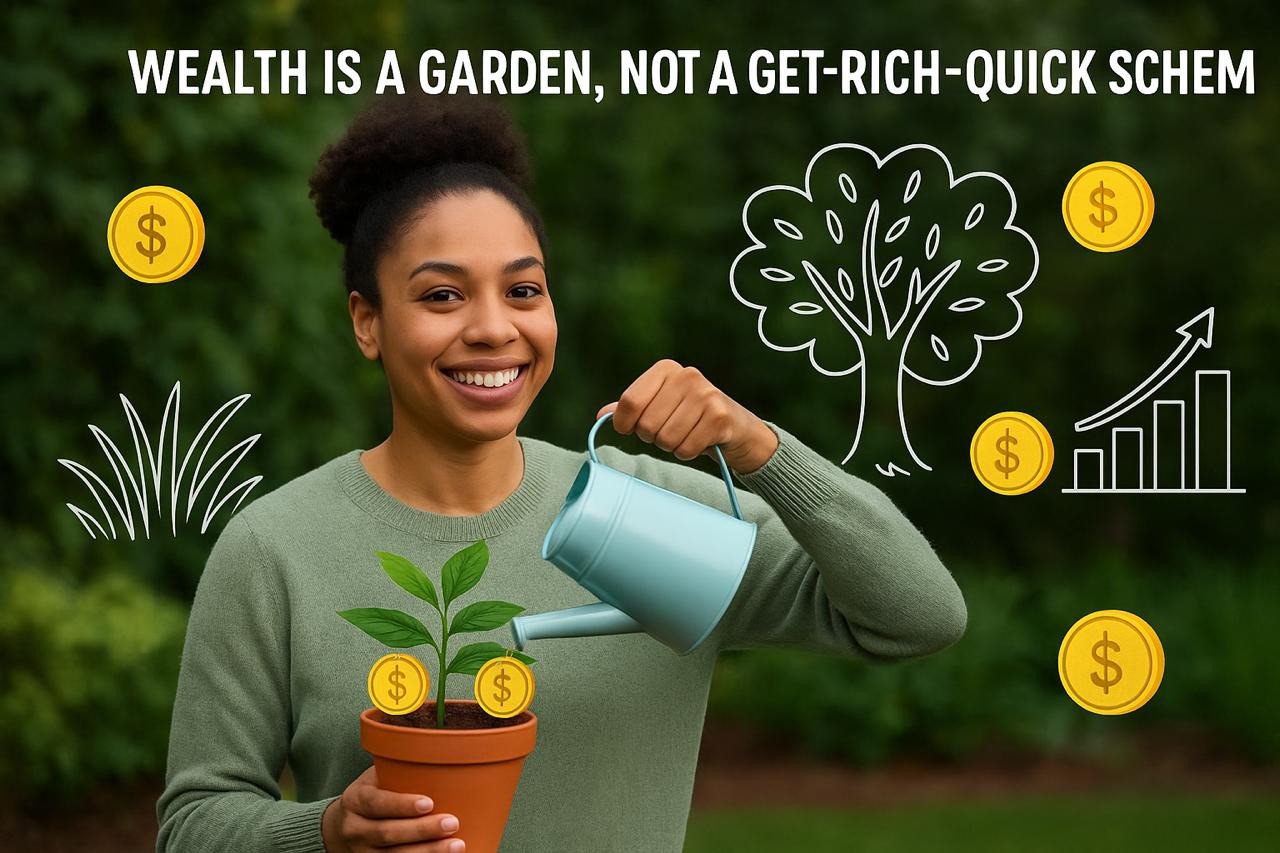Your Wealth is a Living Ecosystem, Not a Quick Payday (Build a Sustainable wealth growth)
Imagine standing in a vast, thriving forest. The towering trees, the buzzing bees, and the hidden mycelium network underground all work together in perfect harmony. Now, think about your finances the same way. Sustainable Wealth Growth is not a lucky break or a jackpot—it is an ecosystem.
Like nature, financial success isn’t about rapid, unsustainable growth. It’s about balance, diversification, and long-term sustainability. So, how do you cultivate your financial garden and make it flourish?
Let’s dig into seven powerful lessons from nature to help you build a resilient, self-sustaining financial ecosystem.
Lesson 1: Diversification = Biodiversity
Nature’s Wisdom:
A healthy ecosystem has a mix of plants, animals, and microorganisms. If a single species dominates, the entire system becomes vulnerable.
Financial Parallel:
Depending on one source of income—like a 9-to-5 job—is risky. If that job disappears, your entire financial system collapses.
How to Apply This for sustainable financial growth:
• List your income sources (salary, freelancing, investments, rental income).
• Identify gaps and start planting new “seeds” (side hustles, passive income).
Example: Mike, an accountant, added an online bookkeeping course to his income streams, earning an extra $2,000/month.
Action Step: Start a low-effort side hustle today—affiliate marketing, tutoring, or selling templates online.
Lesson 2: Compounding (for Sustainable Wealth Growth) = The Mycelium Network
Nature’s Wisdom:
Mycelium—the underground fungal network—quietly supports the entire forest, distributing nutrients and helping trees grow exponentially.
Financial Parallel:
Compound interest is the mycelium of your wealth. Small, consistent investments grow silently but exponentially over time.
The Magic Formula:
• Invest $500/month at 7% annual returns:
• After 10 years: $86,542
• After 30 years: $566,764
Action Step: Automate your investments today. Set up auto-deposits into an index fund or dividend portfolio.

Lesson 3: Pruning = Cutting Financial Deadweight
Nature’s Wisdom:
Gardeners prune dead branches so healthy parts can thrive.
Financial Parallel:
Cutting unnecessary expenses redirects money toward wealth-building.
How to Apply This:
1. Audit your expenses (subscriptions, impulse buys, high-interest debt).
2. Eliminate “financial weeds”—cancel unused memberships, negotiate bills.
3. Reallocate funds—put savings into investments or debt repayment.
Quick Win: Cancel one subscription today. Most people waste over $300/year on unused services.
Lesson 4: Strategic Partnerships = Symbiosis (for sustainable wealth growth)
Nature’s Wisdom:
Bees pollinate flowers, flowers provide nectar. They thrive together.
Financial Parallel:
Your net worth is tied to your network. Mentors, partners, and like-minded peers accelerate financial success.
How to Apply This:
• Find a mentor—offer value in exchange for guidance.
• Join a mastermind group—learn from others and share resources.
• Collaborate—co-invest, start a joint venture, or swap skills.
Example: Two freelancers combined their skills—one did marketing, the other web design. Together, they built a six-figure agency in two years.
Action Step: Reach out to one potential mentor or partner this week.
Lesson 5: Redundancy = Financial Safety Nets
Nature’s Wisdom:
Ecosystems have backups—seed banks, multiple pollinators—to survive disasters.
Financial Parallel:
Having just one backup plan isn’t enough. You need financial redundancy.
Your Financial Safety Checklist:
• Emergency Fund: 6–12 months of expenses in a high-yield savings account.
• Multiple Income Streams: Freelance work, digital products, or passive income.
• Backup Skills: Learn AI tools, copywriting, or a trade to pivot careers.
Example: Airbnb hosts with multiple income streams survived the 2020 crisis 3x better than those relying only on rentals.
Action Step: Open a separate savings account for your emergency fund today.
Lesson 6: Adaptability = Thriving in Market Seasons
Nature’s Wisdom:
Deciduous trees shed leaves in winter to conserve energy; animals hibernate during harsh seasons.
Financial Parallel:
Your strategy should change based on market conditions.
How to Adapt Like a Pro:
• Bull Market (Boom Times): Invest aggressively in stocks, real estate.
• Recession: Focus on dividend stocks, savings, and side hustles.
• Inflation: Invest in TIPS (Treasury Inflation-Protected Securities) and commodities.
Warren Buffett’s Rule: “Be fearful when others are greedy, and greedy when others are fearful.”
Action Step: Review your portfolio and adjust for current market conditions for sustainable financial growth.
Lesson 7: Sustainable Harvesting = Avoiding Burnout
Nature’s Wisdom:
Overfishing depletes oceans; clear-cutting destroys forests. Nature needs balance.
Financial Parallel:
Working 80-hour weeks or obsessing over money leads to burnout and bad decisions.
How to Maintain Balance:
1. Set Boundaries: Work smart, not 24/7.
2. Automate Finances: Use robo-advisors, budgeting apps, and bill autopay.
3. Celebrate Wins: Reinvest 80%, but spend 20% guilt-free.
Example: A crypto trader made $2M in 2021, lost it all by 2023—because he chased money at the expense of strategy and health.
Action Step: Schedule a financial “rest day” this week—no money stress, just reflection.
🌿 Frequently Asked Questions (FAQs) on Sustainable Wealth Growth
❓Q1: What does “sustainable wealth growth” really mean?
A:
Sustainable wealth growth is about building long-term financial success that doesn’t collapse under stress, inflation, or sudden life changes. It’s not just about getting rich fast—it’s about creating a system that consistently generates value, supports your goals, and adapts over time, much like a balanced ecosystem in nature.
Think of it like this: Anyone can plant a seed, but without proper soil, sunlight, and maintenance, it won’t bear fruit. Similarly, real wealth grows sustainably when it’s nurtured through smart planning, discipline, and adaptability.
❓Q2: Can someone with a low income still achieve sustainable wealth growth?
A:
Absolutely. Sustainable wealth growth doesn’t require a six-figure salary—it requires consistent habits, however small they start. Even someone saving $50 per month and investing it wisely can create meaningful long-term outcomes.
The key is:
• Tracking spending
• Avoiding lifestyle inflation
• Building an emergency fund
• Investing early—even in small amounts
Remember: Oak trees grow from acorns. Don’t underestimate what a few small financial habits can do over a decade.
❓Q3: How is building a financial ecosystem different from just budgeting?
A:
Budgeting is just one component of a financial ecosystem. A thriving ecosystem includes diverse elements working together: savings, income streams, investments, risk management (like insurance), and ongoing learning. It’s dynamic.
Think of budgeting as “watering the plant,” while the full financial ecosystem involves planting, watering, pruning, nourishing, and protecting your finances so they can grow over time—this is the essence of sustainable wealth growth.
❓Q4: How can I start creating my own financial ecosystem today?
A:
Start with a few foundational steps:
• Deep Roots: Build an emergency fund (3–6 months of expenses)
• Healthy Soil: Get out of high-interest debt
• Sunlight: Invest in financial education (books, blogs, courses)
• Strong Trunk: Start investing early in diversified portfolios
• Prune Regularly: Trim wasteful expenses each month
Each of these mirrors nature and helps foster sustainable wealth growth. You don’t need to build it all at once—start with one area and let it evolve.
❓Q5: What are some mistakes that prevent sustainable wealth growth?
A:
Here are some common financial “weeds” that choke your financial garden:
• Chasing high returns without understanding risk
• Not having a buffer (emergency fund)
• Ignoring financial literacy
• Lifestyle inflation (spending more as you earn more)
• Thinking short-term (focusing only on the next paycheck)
Avoiding these can drastically improve your odds of achieving sustainable wealth growth. Like in nature, balance and long-term planning matter far more than short-lived intensity.
❓Q6: How often should I review my financial ecosystem?
A:
Just like a gardener checks in regularly, your finances need periodic tending. Here’s a quick review calendar:
• Monthly: Budget check-in, expense review
• Quarterly: Investment performance and asset allocation
• Annually: Tax planning, insurance review, goal adjustments
Rebalancing regularly ensures your financial environment stays healthy and aligned with your evolving goals. This rhythm supports sustainable wealth growth without burnout or surprises.
❓Q7: How does this concept apply to couples or families?
A:
In a family, a financial ecosystem must be collaborative. Communicate openly about shared goals, build joint systems (emergency fund, investments, insurance), and divide responsibilities. Teaching kids early about money can plant seeds of sustainability for the next generation.
When the whole family works together—like a symbiotic forest—the potential for sustainable wealth growth multiplies.
❓Q8: Can passive income alone lead to sustainable wealth growth?
A:
Passive income is powerful but it’s not magic. Many people assume earning while sleeping is enough—but sustainable wealth requires managing that income too. Diversifying income streams, reinvesting earnings, and adjusting for taxes and inflation all matter.
Passive income is a branch of your ecosystem—but it still needs sunlight and care to grow.
❓Q9: I’ve made past financial mistakes. Is it too late to start?
A:
Never. Even damaged soil can be revitalized with care. Start by:
• Acknowledging the mistake
• Learning from it
• Taking one small positive step today
Many successful people started after setbacks. Nature bounces back—and so can you. Remember: Sustainable wealth growth is about consistency, not perfection.
🧠 Final Tip:
Use the blog’s 7 lessons from nature as a monthly checklist. Focus on one principle each week and build your personal roadmap for lasting wealth.

Your Financial Ecosystem Health Quiz
Score yourself (1–5) on these:
1. Do I have ≥3 income streams?
2. Do I reinvest ≥10% of my earnings?
3. Have I cut wasteful expenses in the last 90 days?
4. Do I have a mentor or accountability partner?
5. Is my emergency fund fully funded?
Results:
• 15–20 Points: Your ecosystem is thriving!
• 10–14 Points: Time to prune and diversify.
• <10 Points: Start planting financial seeds today.
Conclusion: Sustainable Wealth Growth Like a Redwood—Strong, Steady, and Rooted in Systems.
“Nature doesn’t rush, but it achieves miracles over time.”
By applying these natural principles to your finances, you will build wealth that lasts for decades—not just until the next market crash.
Your Action Plan:
1. Start one new income stream this month.
2. Automate your investments today.
3. Share this post and tell us: Which financial lesson from nature resonated with you the most?
Subscribe to TheFitFinance!
To understand a different way to have sustainable wealth growth just click here > Is a Credit Card a Source of Income? “YES” – 12 Powerful Ways to Make Your Card Work for You








